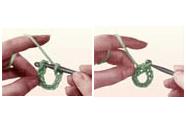
Materials :
Hooks made of steel, plastic, aluminium and wood are available in different
lengths and sizes. Steel hooks are usually used for cotton thread or fine wool
work, plastic and aluminium hooks for wool, synthetics etc and wooden hooks for
heavy wool (rug making).
Yarns and threads are available in a variety
of materials like wool (light, medium and heavy), cotton , synthetic, jute and
so on.
Gauge
Gauge means the number of stitches
and rows per inch. Gauge will be specified in the directions given in a particular
design. When you do crocheting , it is important to maintain the gauge specified
in the design to get the correct size of the article you are making.
To
check the Gauge, make a sample 3 or 4 inches square patch of the stitch
given. Stitch using the specified hook and yarn. Then place the patch flat on
the table and with a ruler measure the number of stitches and rows per inch.
For eg. Gauge= 4 stitches per inch.
If your stitch number doesn't correspond
to the Gauge given for the design, try out different size hooks i.e a larger hook
if you have more stitches per inch or a smaller hook for less stitches per inch
until the Gauge specified is obtained.
Method :
Slip stitch is used for joining. It is also used
for straight rows of crochet and is often used as an edge stitch.
-
Make a starting chain of 10 stitches.
-
Insert hook through the two top threads of first chain made.
Yarn over and with one motion draw through stitch and loop on hook. |
 |
 |
|


